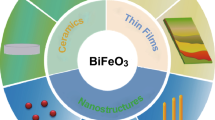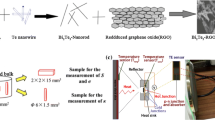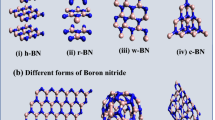Abstract
The current tendency toward miniaturization of electronic devices has driven the interest in developing ferroelectric materials in low dimensions. In this work, for the preparation of lead-free BaTiO3 nanoparticles, we used a combination of the sol–gel method with the reverse micelles techniques. Moreover, previously to the thermal treatment, it was necessary to remove the surfactant. For this stage, oleic acid was used to stabilize the nanoparticles in the solution. Then, nanometer-sized particles were deposited on different substrates (Si, Pt/TiO2/SiO2/Si). The influence of different modes of deposition on particle size, degree of agglomeration, was analyzed. The mean particle size was 10 nm. Finally, the deposition of BaTiO3 particles on a conductive substrate such as the wafer of platinum (Pt/TiO2/SiO2/Si) was confirmed by several AFM techniques.












Similar content being viewed by others
References
Alexe M, Hesse D (2006) Self-assembled nanoscale ferroelectrics. J Mater Sci 41:1–11
Cai W, Fu C, Gao J, Guo Q, Deng X, Zhang C (2011) Preparation and optical properties of barium titanate thin films. Phys B 406(2011):3583–3587
Calzada ML, Torres M, Fuentes-Cobas LE, Mehta A, Ricote J, Pardo L (2007) Ferroelectric self-assembled PbTiO3 perovskite nanostructures onto (100) SrTiO3 substrates from a novel microemulsion aided sol–gel preparation method. Nanotechnology 18:375603
Fang T, Hsieh H, Shiau F (1993) Effects of pore morphology and grain size on the dielectric properties and tetragonal cubic phase transition of high-purity BaTiO3. J Am Ceram Soc 76:1205–1211
George CN, Thomas JK, Kumar HP, Suresh MK, Kumar VR, Wariar PRS, Jose R, Koshy J (2009) Characterization, sintering and dielectric properties of nanocrystalline barium titanate synthesized through a modified combustion process. Mater Charact 60:322–326
Harizanov O, Harizanova A, Ivanova T (2004) Formation and characterization of sol-gel barium titanate. Mater Sci Eng B 106:191–195
Horcas I, Fernandez R, Gomez-Rodriguez JM, Colchero J, Gomez Herrero J, and Baró AM, (2007) Review of science instruments 78, 013705
Jung W-S, Min B-K, Park J, Yoon D-H (2011) Formation mechanism of barium titanate by thermal decomposition of barium titanyl oxalate. Ceram Int 37:669–672
Lee YJ, Jun KW, Park JY, Potdar HS, Chikate RC (2008) A simple chemical route for the synthesis of γ -Fe2O3 nano-particles dispersed in organic solvents via an iron-hydroxy oleate precursor. J Ind Eng Chem 14:38–44
Moran D, Bowmaker GA, Cooney RP, Bartlett JR, Woolfrey JL (1995) Vibrational spectra of metal salts of Bis(2 = ethylhexyl)sulfosuccinate (AOT). J Mater Chem 5(2):295–302
Naumov I, Bellaiche L, Fu H (2004) Unusual phase transitions in ferroelectric nanodisks and nanorods. Nature 432:737–740
O’Brien S, Brus L, Murray CB (2001) Synthesis of monodisperse nanoparticles of barium titanate: toward a generalized strategy of oxide nanoparticle synthesis. J Am Chem Soc 123:12085–12086
Pileni MP (1993) Reverse micelles as microreactors. J Phys Chem 97:6961–6973
Randall C (2001) Scientific and engineering issues of the state-of-the art and future multilayer capacitors. J Ceram Soc Jpn 109:S2–S6
Rüdiger A, Schneller T, Roelofs A, Tiedke S, Schmitz T, Waser R (2005) Nanosize ferroelectric oxides—tracking down the superparaelectric limit. Appl Phys A 80:1247–1255
Satapathy S, Gupta PK, Srivastava H, Srivastava AK, Wadhawan VK, Varma KR, Sathe VG (2007) Effect of capping ligands on the synthesis and on the physical properties of the nanoparticles of LiTaO3. J Cryst Growth 307:185–191
Scott JF, Morrison FD, Miyake M, Zubko P (2006) Nanoferroelectric materials and devices. Ferroelectrics 336:237–245
Stachiotti M, Sepliarsky M (2011) Toroidal ferroelectricity in PbTiO3 nanoparticles. Phys Rev Lett 106:137601
Tangwiwat S, Milne S (2005) Barium titanate sols prepared by a diol-based sol-gel route. J Non-Cryst Solids 351:976–980
Tauc J (1974) Amorphous and liquid semiconductor. Plenum Press, New York, pp 159–220
Torres M, Pardo L, Ricote J, Fuentes-Cobas LE, Rodriguez BJ, Calzada ML (2012) Fabricating ordered functional nanostructures onto polycrystalline substrates from the bottom-up. J Nanopart Res 14:1108
Trbojevich R, Pellegri N, Frattini A, de Sanctis O, Almeida RM (2002) Preparation and isolation of gold nanoparticles coated with a stabilizer and sol-gel compatible agent. J Mater Res 17(8):1973–1980
Uskoković V, Drofenik M (2007) Reverse micelles: inert nano-reactors or physico-chemically active guides of the capped reactions. Adv Colloid Interface Sci 133:23–34
Acknowledgments
N.M. acknowledges CONICET by the postdoctoral scholarship. The authors thank Julio Ferrón and Mario Paseggi (IFIS-UNL) for their assistance with the Kelvin Probe AFM technique and Nestor Delorenzi (FCByF-UNR) for providing the DLS equipment. The authors also thank CONICET and UNR for the financial support.
Author information
Authors and Affiliations
Corresponding author
Rights and permissions
About this article
Cite this article
Mamana, N., Pellegri, N. Functional BaTiO3 nanostructures immobilized onto si-based substrates using sol–gel and reverse micelle techniques. J Nanopart Res 17, 115 (2015). https://doi.org/10.1007/s11051-015-2930-8
Received:
Accepted:
Published:
DOI: https://doi.org/10.1007/s11051-015-2930-8




